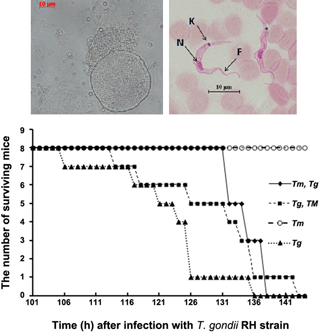Published online by Cambridge University Press: 04 February 2021

Toxoplasma gondii can infect almost all warm-blooded vertebrates with pathogensis being largely influenced by the host immune status. As important epidemiological hosts, rodents are globally distributed and are also commonly found infected with haemoflagellates, such as those in the genus Trypanosoma. We here address whether and how co-infection with trypanosomes can influence T. gondii infection in laboratory models. Rats of five strains, co-infected with T. lewisi and mice of four strains, co-infected with T. musculi, were found to be more or less susceptible to T. gondii infection, respectively, with corresponding increased or decreased brain cyst burdens. Downregulation of iNOS expression and decreased NO production or reverse were observed in the peritoneal macrophages of rats or mice, infected with trypanosomes, respectively. Trypanosoma lewisi and T. musculi can modulate host immune responses, either by enhancement or suppression and influence the outcome of Toxoplasma infection.